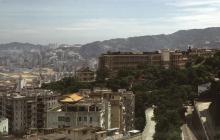Historic maps at the Survey & Mapping Office (SMO)
Primary tabs
[2020 update: The notes below were written in 2017. The SMO has since made a lot more of its maps available online. See this tutorial for details of how to access them.]
The SMO is a good source for historic maps of Hong Kong. The SMO kindly spent time to explain their services to me. Here's a summary of my understanding:
1. Finding the map you want
1.1 1:600 scale topographic maps, c.1922-1970s.
There are two sets of sheets. The first covers the years c.1922-c.1935, the second covers c.1935-1970s. Not all maps are available for all years.
You can see an outline of what each sheet covers, and view a low-resolution copy of each sheet online. Start at https://www1.hkmapservice.gov.hk, choose your language, (if you see a "Checking for configuration..." with a scary-looking alert notice, just click "Continue") and you should reach the "Hong Kong Map Service" website.
Click Paper Map Product > Products > Topographic maps. Choose the series you are interested in and click the green arrow. Now zoom in on the map to see the reference number for the sheet covering the area you are interested in, choose that sheet from the drop-down list, and click the green arrow. It shows a list of years available for that sheet. Click the magnifying glass icon on the line for the year you are interested in to see a low-resolution copy of the sheet.
If you follow the same procedure on one of the SMO's map kiosks, they show you high-resolution copies of the sheet. You can either note down the information you need, or order a copy of the sheet. Kiosks are available at all of the map sales outlets.
1.2 Other historic maps, 1845-1970
The SMO also have an assortment of approximately 400 maps of Hong Kong from the 19th & 20th century. To see these, you need to visit the Map Publications Centre (23/F, North Point Government Offices, 333 Java Road, North Point. Mon-Fri 08:45 a.m. – 05:30 p.m.)
At the counter you can either ask for the "Index of historical maps" (a printed spreadsheet listing details of all the maps), or the "samples of historical maps" (folders with printed, reduced-size copies of all the maps).
You can note down the information you need from the samples, or order a copy of the sheet. The printed copies are larger than the samples.
2. Ordering a copy of the map for private research
The 1:600 maps can be ordered online from the Hong Kong Map Service website described in 1.1 above, or at any map sales outlet. The other historic maps should be ordered at the Map Publications Centre.
You can order a printed copy @ HK$47 per sheet. (Digital copies of these historic maps are not available to purchase.)
3. Posting a map online to Gwulo or another website
The SMO have two different processes, depending upon who was the original publisher of the map. You can find the publisher for each map by looking it up in the "Index of historical maps".
3.1 Publisher is The Government of HKSAR
Maps in this category have one of the following descriptions for "Publisher" in the "Index of historical maps":
- C.L. & S.O.
- Hong Kong Government
- Public Works Department
The Government charges for the display of any of their maps online, even their historic maps. This is explained on their "Internet Map Permittee (IMP) Service" page.
I don't have the resources (cash & manpower) to handle the administration of this, so for now we cannot show historic maps where the publisher is The Government of HKSAR.
3.2 Publisher is not The Government of HKSAR
Maps in this category have one of the following descriptions for "Publisher" in the "Index of historical maps":
- "-", ie not listed
- Ordnance Survey
- Surveyor General Office
- War Department
- War Office
In this case, once we have ordered a copy we have to work out whether the original publisher allows the map to be displayed on a public website or not. As the maps are so old I believe there won't be any problem with this, but we'll have to investigate for each the different publishers listed above.


I created a tutorial on how
I created a tutorial on how to use the new Survey & Mapping Office (SMO) system here